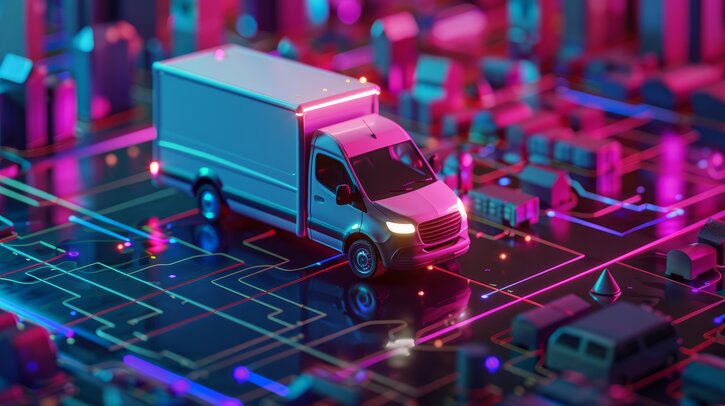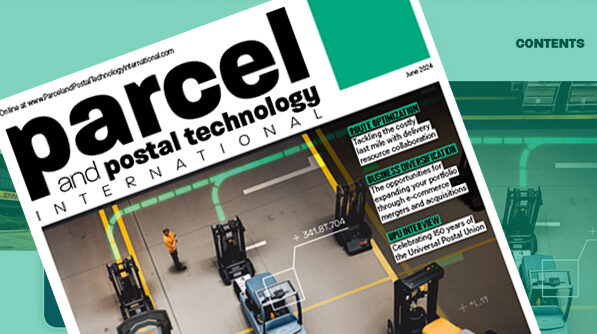According to the most recent data from the Society of Motor Manufacturers and Traders (SMMT), record numbers of commercial vehicles are now in use on the UK’s roads, with 625,873 HGVs and 5,012,632 vans in operation in 2023, up by 1.7% and 2.6% year-on-year, respectively. The gradual shift to zero-emission power is reducing the impact of these vehicles on the environment – one in 40 of all vehicles on UK roads are now zero emission, including 2,383 HGVs, for example – but issues concerning congestion on our roads remain. Furthermore, heavily congested roads have a big impact on the operational efficiencies of logistics and supply chain firms.
Many of the journeys undertaken by HGVs occur with either a partial or an empty load. UK Department for Transport domestic road freight statistics have identified that approximately 30% of all HGV journeys are without a load. Figures released by Digital Catapult, the UK authority on advanced digital technology, reveal that 50% of trucks on the road are only 25% full, putting significant cost pressures on everyone across the end-to-end manufacturing supply chain.
The Logistics Living Lab
Digital Catapult’s Made Smarter Innovation | Digital Supply Chain Hub is a national program working to advance and accelerate the understanding and inclusion of digital technology in UK supply chains. In April 2023 it launched the Logistics Living Lab (L3) to address the last-mile challenges and help reduce the carbon emissions of delivery trucks on the roads. This flagship project will run until September 2024.
It aims to reduce congestion, improve the customer experience and bring the UK closer to its ambition of net zero by 2050 using technology to better coordinate logistics and reduce the number of empty and nearly empty delivery trucks on the roads.
“The main aim of the project is to reduce carbon emissions and inefficiency within supply chains,” says Dr Amar Dhokia, senior product manager at Digital Catapult and manager of L3. “We are aiming to achieve this through better transport collaboration to reduce wasted capacity, increase truck utilization and, in effect, take empty miles off the road.”
The project brings together several leading digital innovators, logistics companies and manufacturers to develop, demonstrate and test a shared digital infrastructure based on a combination of advanced digital technologies, such as IoT, AI and distributed ledger technology (DLT). The shared digital infrastructure will enable more intelligent management of vehicle slot filling, routing and tracking to allow competing logistics providers to safely share information on available truck space across their collective fleets, without the need for a single party to have full control or visibility of the whole system.
According to L3, improving last-mile logistics in this way will decrease urban particulate emissions by 10%, with a 10% reduction in urban congestion after 10 years of operations. It will also give a more than £10bn (US$12.7bn) boost to UK GDP and lead to an increase in urban life expectancy. This is because emissions currently cause 40,000 premature deaths per annum in the UK, according to L3.

L3’s project partners
“L3 is being run as a collaborative research and development project,” says Dhokia. “It includes several phases including discovery, solution development and demonstration phases. We are currently in the demonstration phase. The discovery phase was all about identifying the key target areas that the shared digital infrastructure solution could help with, which is, in a nutshell, optimizing the complex logistics processes through better collaboration.”
L3 worked with five firms during this discovery phase – the Vodafone Digital Asset Broker, Microsoft, Yusen Logistics, Fuuse and Parity Technologies. As the project moved on to the solution development and demonstration phases, other project partners were added, including food retail, wholesale and distribution company Blakemore, digital asset broker Pairpoint, and Inception Consulting.
“Digital Catapult is the lead partner on the project,” explains Dhokia. “The concept of the shared infrastructure lives within Digital Catapult. In projects like this, we develop solutions that act as demonstration pieces to bridge the gap between ideas and research and market-ready solutions. They are not necessarily intended for immediate commercialization. However, we have now built the shared infrastructure solution for L3 and we’re looking to scale that up through multiple test projects.”

Prior to the demonstration phase, L3 worked closely with its primary logistics partner, Yusen Logistics, to pinpoint the key market challenges – such as ensuring the right service levels and a willingness from firms to collaborate – and identify ideas for how to overcome them. According to Yusen Logistics, the project enables logistics companies to collaborate and still compete in new and more efficient ways, with new business and governance models allowing the companies to work together to mutual advantage, reducing costs while working toward a more sustainable future.
The technology
Following the demonstration phase, L3 and the project partners set about building the shared infrastructure solution. “The tool we have developed is called Sequence, and it is now cloud hosted ready for demonstration,” explains Dhokia. “It is a shared utility that any participant can use. The tool enables seamless and secure data sharing between companies that are looking to ship goods and those who have capacity to transport them.
It uses an algorithmic matchmaker that reads anonymized data and makes proposed matches. It has a privacy-preserving mechanism built in, enabling users to share data, such as transport capacity or order information, on a granular basis and then the third-party algorithmic matchmaking service accesses that data and proposes matches. Users then approve whichever service they want to use.
“And because users control their own data source, they can choose on a granular level who is able to access the information, and at any point, if they do not want to participate, they are allowed to retract their data,” Dhokia continues.
According to Dhokia, this is just one small part of what Sequence could offer. “There could be multiple matchmaking algorithms, for example. It could be used for inventory management or for CO2 reporting. Transport collaboration is just one use case that can be used to generate value, but in theory you could have many different applications.”
L3 worked with EV chargepoint management platform Fuuse to develop the matchmaking algorithms, with Microsoft for the cloud infrastructure on which Sequence is hosted, and also with blockchain firm Parity Technologies. “Our Sequence tool is built on Parity’s open-source technology and the company also undertook an advisory role during the development phase,” says Dhokia.
The L3 team also worked with Pairpoint throughout the discovery phase to look at how IoT technologies and sensors could be used as agents rather than just recurrent data feeds. “In practice, this could create more intelligent supply chains,” says Dhokia. “The sensors in a truck, for example, could report on how much space is in that vehicle at any given time and track specific assets such as pallets. A report will be produced on the key findings from this work soon.”

Testing, testing
The L3 project has now moved on to the demonstration and testing phase to gather some “concrete, grounded results” to prove the benefits of using the Sequence tool. “During this phase, Blakemore is the main partner,” explains Dhokia. “We are also working with Incept Consulting to undertake a lot of the data analysis.
“Blakemore is a wholesaler that also runs around 250 Spar retail stores across the UK and operates its own logistics operation, which services its retail locations. During the demonstration phase we are using spare capacity in Blakemore’s trucks to pick up orders from suppliers that are supplying to Blakemore’s distribution centers. The collaboration here is between Blakemore, its manufacturers and its suppliers,” Dhokia adds.
The data gathered during the testing phase will be compared with baseline, historic data from previous transportation operations. The results will then be analyzed to find out the key benefits of the collaboration, such as how much capacity has been used and how the project has removed vehicles from the roads. “This final part is being undertaken in the coming months, and the initial results will be available over the summer,” Dhokia explains.
Dhokia is confident that the results will illustrate the clear benefits of transportation collaboration for the supply chain sector. “The project is due to end in September but we are currently exploring possible routes for funding to continue the work. All parties involved in L3 are already bought in – they know how beneficial Sequence would be to the supply chain sector.
“Alongside this, we are constantly validating with industry to gauge what the potential adoption uptake could be. We do this through the Digital Supply Chain Hub’s Observer Gallery initiative, which brings together a shortlisted group of industry stakeholders from logistics companies, retailers, manufacturers, etc, to disseminate the project’s finding so far and to gather feedback on the best way forward. It is important for us to have the industry’s input on the future of the L3 project,” Dhokia notes.
While the industry and L3 project partners await the concrete results from the testing phase, Dhokia stresses the value the Sequence tool could bring to the wider supply chain sector: “We are proving that with just the Blakemore use case, value can be added to the supply chain. In this instance, we are streamlining a process that is quite laborious. In theory, the approach could be scaled up to every transportation provider in the country. The bigger it gets, the greater the economies of scale.
“However, it’s important to remember that even on a small scale, transportation emissions can be reduced, efficiency improved and operations simplified. If nothing else, the L3 project demonstrates that value-based collaboration can happen within logistics. The technology is ready. This is a massive step forward.”
 Dynamic route optimization solutions from Giro
Dynamic route optimization solutions from Giro
Giro, a provider of route planning and optimization software to posts, believes that dynamic route optimizationsolutions can help logistics firms tackle current industry challenges and trends including sustainabilitydemands, new delivery models, fluctuating volumes and increasing consumer expectations.
“Route optimization providers are crucial partners for posts as they transform to meet the needs of today’s market,” explains Bastian Schilling, business development director for GeoRoute, Giro’s routing software. “Giro, for example, offers solutions that can not only help posts optimize costs but also enable the seamless adjustment of routes in changing operating conditions.”
Schilling also notes how increased digitalization is helping routing solutions such as GeoRoute improve their offerings. “The increased volume of data this brings helps create more precise volume forecasts,” he says. “This enables the better preplanning of sustainable scenarios while ensuring efficient operations on the day of delivery.”
Giro has recently expanded its product range to include new dynamic route optimization solutions that are specifically designed to address changing volumes and product types. “As a software provider, we appreciate that dynamic optimization reduces costs by reducing mileage. However, we keep in mind that the stability of delivery areas and sequences is also crucial for efficient operations,” Schilling explains.
“The advances made in our new solutions account for the additional costs incurred by operational changes, which are often overlooked in purely mathematical optimization models. Achieving the right balance between flexibility and stability is essential for achieving real savings,” he continues.
Looking to the future, Schilling believes that AI and machine learning will play a crucial role in enhancing the quality of data used in route optimization. These technologies will help improve the decision making process by analyzing large data sets, predicting consumer and traffic patterns and providing valuable new input for the algorithms.
“Customization and personalization will also be a key trend in the future,” he adds. “Increased data and the insights it brings will drive the development of more customized and personalized solutions, tailored to meet the specific needsof each organization and market,” he concludes.
 Reducing emissions with high-density routing
Reducing emissions with high-density routing
RouteSmart Technologies aims to push the boundaries of what efficient route optimization can achieve – not just in terms of operational excellence but also in environmental stewardship. The company’s advanced route planning and optimization solutions are specifically engineered to address the unique challenges of high-density routing for postal and parcel delivery fleets, significantly reducing emissions and promoting a healthier planet.
By ensuring that each vehicle travels the shortest and most efficient path possible, RouteSmart’s technology effectively decreases the total kilometers driven across the fleet. This reduction in mileage translates directly into lower fuel consumption and significantly less CO2 emission.
For a fleet of 1,000 vehicles and an efficiency gain of 8% from using route optimization and planning solutions to improve operations, there is an average reduction of 153 tons of CO2 per month for the fleet.
RouteSmart’s optimization algorithms start with the best digital street data available and analyze the most critical data to maximize delivery efficiency and minimize environmental impact.
Moreover, RouteSmart incorporates historic traffic data, turn variables and side-of-street factors to improve route efficiency. This adaptability not only enhances delivery reliability but also decreases the likelihood of unnecessary idling and detours, which are common contributors to excessive fuel use and emissions.
The technology’s high-density routing capabilities mean that each delivery vehicle can handle more stops with optimal efficiency. This is particularly crucial for large vehicles in urban environments, where precision in routing can make a substantial difference in time saved and emissions reduced. By maximizing the delivery capacity per trip, RouteSmart helps lower operators’ carbon footprints and slash fuel costs.
The technology equips the delivery fleet to do more with less, ensuring that operators meet not only their delivery goals but also their sustainability targets.
This article was originally published in the June 2024 issue of Parcel and Postal Technology International.



